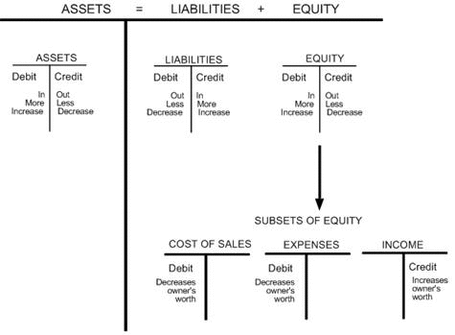

This two-column structure lets you see at a glance when money is going out of your company and when it is coming in. Debits are recorded in a single column on the ledger sheet, while credits are listed in a separate column beside the debit column. By splitting incoming funds from outgoing funds, it's easier to understand what's going on in your accounting ledger. The use of debit versus credit recording is part of the technique known as double-entry accounting.

So now that you've figured out what debits and credits are, what should your business use them for? Is there increased shareholder investment that leads to an increase in your overall share price? That's a check in two different categories. A new loan to cover your business expansion? Check. If you're not sure, apply your mnemonic and see if the money meets one of the categories of a credit. Just as debits are all the money going out of your business, credits are all the money coming in. The S is for "shareholder equity," which is the money that shareholders have put into the company through investment. The L is for "liabilities" which is income derived from a loan or other debt from an outside source. This also means that R stands for "revenue," which is money earned through sales or services. The I stands for "income," which is money that comes into your company not counted as a gain or revenue. The G stands for "gains," which represent increases in the company's share price. When you're talking about your company's financials, a credit is a good thing it's the money that comes into your company, similar to how a debit is the money that goes out of your company.Īs with the definition of debit, there is a helpful mnemonic to keep track of what constitutes a credit in the business world: GIRLS. The credit definition in accounting is different, however. So if debits are the money going out of your business, what does that make credits?Īs a consumer, you may think of credit as a secured or unsecured line of debt that you borrow against these are most commonly seen in credit cards and other lines of credit.

Payroll, taxes and other business expenses also qualify as debits, as does the money lost when a big business investment falls through. You can easily remember that the money drawn out of petty cash is a debit, as is the money spent on a new printer, new office space or the acquisition of other assets. If you want to make sure, though, you can use this mnemonic to check. "Losses" are just what they sound like, investments that go south or other situations that cause the company to lose money.Įssentially, any money going out of your company is a debit. "Assets" refers to money that's spent on the acquisition of physical assets, equipment or real estate. "Expenses" are operating expenses, including costs such as utilities and payroll. In this case, "draws" are cash withdrawals or any other unaccounted-for cash that goes out of your business. You can use this to remember that all debits are Draws, Expenses, Assets or Losses. Below provided debit credit in excel template is ready to use and available here for free.If you have trouble keeping track of what a debit is, think of the word DEAL. It is also named as general ledger in which a company or business records its day to day financial transactions and details. Data of the debit credit in excel template can be used then in making annual financial statements. Using great features of Ms excel one can plan and record all money coming in and going out of the organization.ĭebit credit in excel template is a useful accounting spreadsheet that lets a company or individual person to record all money related transactions such as payment received as well as expense incurred in a particular period of time. In this era of advanced technology large number of useful techniques and ways is accessible for easy and simple accounting and one of them is MS excel. Most of companies use debit & credit sheets to record financial deals or transactions of the company or business to record them in writing format. It sounds like one of the basics of accounting or bookkeeping procedure. Keeping track of incomes and spending of a business establishment or company is vital to make the accounting process fluent. Description of debit credit in excel templates Accounting department plays a vital role in almost all fields of life when it comes to track incomes and expenses of a business establishment or company to find out actual figure of profit generated or loss occurred and debit credit or general ledger is the basic accounting tool to keep track of all financial transactions of the company in an organized way to prepare further financial statements and reports for financial reporting process. This web page has debit credit in excel template for you that can work well for you when managing accounts for a business organization or for personal use.


 0 kommentar(er)
0 kommentar(er)
